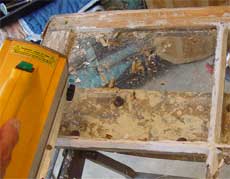
Repairing Old Wood Windows — Step-By-Step
Part 1: Repairing and Removing Glazing and Paint
Next: Part 2: Glazing, painting, and weather stripping »
Additional information on the web:
Repairing old windows![]() (Old House Web)
(Old House Web)
Repairing old windows![]() (National Park Service).
(National Park Service).
We stripped the old paint using our Infrared paint remover. A semi sharp chisel was used to remove the caulk once it was heated. A heat gun can be used, but it will crack the glass and can burn the wood if you aren't careful.
Using a chisel or paint scraper (see photo), pry away any glazing that is loose. Again we used our infrared paint remover to soften the glazing. You can also use a heat gun on low being careful not to heat the glass so it cracks or burns the wood. In the photo, note that the infrared paint remover will not break the glass if it is at its highest position.
For safety, wear eye protection and use gloves to protect your hands from the heat and the glass.
Once you 'break' the surface of the old putty, the remainder of the removal is much easier, because the heat can how get do the wood below. If there are missing sections of putty, then start removal there.
Watch for the points holding in the glass. You might want to save these glazing points, since some of the newer points are too large for older windows.
Sometimes the glass just lifts out of the window frame. However, if the glass is stuck to the old glazing, we found that moving the heater 1 to 3 inches above the glass for 15-30 seconds would soften the old glazing enough so that we could push up on one edge of the glass and carefully lift it out.
Again, a heat gun on high also can be used.
Average time to do the above work is one hour per six pane window
Once the old glazing is removed as well as the glass, scrape the mullions with the triangular scraper to remove any glazing or old paint. Sand and scrape to reach the original wood.
Paint the exposed wood with either a primer or use an epoxy consolidant. The epoxy will soak into the wood and make it harder than original as well as waterproof. You also should fill any holes with an epoxy filler.
DAP, the makers of Dap 33 glazing, says the reason to prime any raw wood with an exterior oil base paint [or with the epoxy consolidant above] prior to glazing, is to keep the wood from drawing the oil out of the glazing, therefore preventing the glazing drying out and cracking loose in a year or two. Linseed oil is not recommended for this anymore.
After the epoxy consolidant has dried for a least one day, fill any holes with the epoxy filler.
Next: Part 2: Glazing, painting, and weather stripping »
|
Help support this site
|







